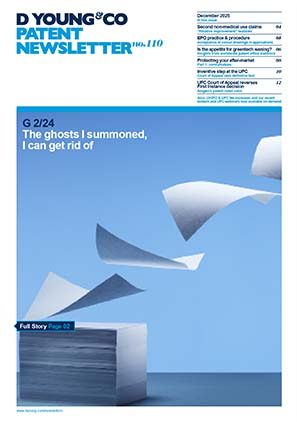Unified Patent Court: auxiliary claim requests
Amidst the buzz of rapidly developing patentability and infringement case law at the Unified Patent Court (UPC), you could be forgiven for overlooking the formal requirements underpinning its day-to-day operation.
In the first in a series of articles discussing the UPC’s burgeoning procedural case law, we will take a look at what is considered a “reasonable” number of auxiliary claim requests.
EPO v UPC
The idea of filing a number of auxiliary claim requests will not be new to those familiar with opposition and appeal proceedings at the European Patent Office (EPO). Usually, the patentee will file a most-preferred main request alongside one or more additional auxiliary requests numbered in order of preference should the main request be rejected.
There is no official set limit on the number of auxiliary requests that can be filed during opposition and appeal proceedings at the EPO. Indeed, in more complex proceedings, the number of auxiliary requests can even reach hundreds.
In a similar vein, Rules 30 and 50 of the Rules of Procedure (RoP) of the UPC permit the proprietor of a European patent subject to a revocation action to lodge an application to amend the claims (and/or specification) of the patent.
However, unlike at the EPO, Rule 30.1(c) RoP of the UPC states that auxiliary claim requests must be “reasonable in number in the circumstances of the case”.
It has been left to the various divisions and courts of the UPC to interpret and apply this (perhaps deliberately) vague language.
How many auxiliary requests is reasonable?
In 10x Genomics & Harvard v Nanostring (UPC_CFI_298/2023), the judge-rapporteur at the Munich Local Division initially held that 10x and Harvard must reduce its 55 auxiliary requests to a single digit number, agreeing with Nanostring that 55 auxiliary requests was excessive.
However, on full panel review, it was held that the reasonable number of auxiliary requests depends on the scope of the counterclaim for revocation and the complexity of the case. The full panel noted that the case under consideration was extremely complex, and concluded that, even though the number of auxiliary requests may be extremely high, this does not necessarily mean that the number is unreasonable. This approach is aligned with that of the Paris Central Division in Edwards v Meril (UPC_CFI_255/2023), where the Paris Central Division held that 84 auxiliary requests was a reasonable number in view of the complexity of the case.
However, such a large number of auxiliary requests has not always been accepted at the UPC. In Kunststoff v Häfele (UPC_CFI_526/2024), the Munich Central Division rejected Häfele’s submission of two sets of 40 auxiliary requests, for a total of 80. Häfele had argued that parallel ongoing proceedings for the patent in suit and other patents in the family as well as the possibility of conflicting decisions meant that the high number of auxiliary requests was justified. The Munich Central Division noted that these parallel proceedings were at a much more advanced stage than the UPC proceedings, so Häfele should have been able to narrow to the most relevant auxiliary requests based on the key issues in the other parallel cases.
The Munich Central Division also took issue with the way in which Häfele had presented its auxiliary requests. Although the Munich Central Division noted that there was no requirement in the European Patent Convention (EPC) that the requests are convergent, the manner in which they had been presented made it “unduly difficult” for both the claimant and the court to prepare for the hearing. The court concluded that up to 10 auxiliary requests would likely be considered reasonable under the specific circumstances of the case.
A further case where the UPC considered the meaning of a “reasonable number” of auxiliary requests can be found in NJOY v Juul (UPC_CFI_316/2023). In this case, the Paris Central Division noted that the complexity of the case meant that 12 auxiliary requests would have been considered reasonable. The court also passed another interesting comment, noting that there is no provision to dismiss all auxiliary requests as a whole simply because they are considered too numerous.
What is the impact of parallel EPO proceedings?
It is becoming increasingly clear that the EPO and UPC are keeping a close eye each other’s decisions, ostensibly in an effort to ensure harmonisation between the two organisations and to provide legal certainty for parties. Indeed, in two recent decisions, the EPO’s Opposition Division and Boards of Appeal have directly referred to UPC decisions (see the recent Opposition Division decision for EP3666797 and the Board of Appeal decision in T 1535/23).
How, then, will parallel EPO proceedings influence the auxiliary requests allowed in cases at the UPC?
In the 10x Genomics & Harvard v Nanostring case discussed above (UPC_CFI_298/2023), the Munich Local Division passed an interesting comment regarding the impact of parallel EPO proceedings. Acknowledging that the reasonable number of auxiliary requests could not be determined until opposition proceedings had concluded, the Munich Local Division noted that auxiliary requests which are subject to the parallel proceedings before the EPO at the time of the decision of the Opposition Division will be allowed also within the present proceedings. This could be taken as an indication that parties will be allowed to present their complete case from opposition proceedings at the UPC, but the Munich Local Division did not develop its point further.
However, it is important to note that the auxiliary requests under consideration in the parallel proceedings before the EPO could be considered to form part of the patentee’s original case. Therefore, the auxiliary requests effectively represented a reduction in the number of auxiliary requests under consideration before the UPC.
Unfortunately, we will not get further clarity in this line of cases, since the 10x and Harvard v Nanostring dispute appears to have come to an end with a settlement between 10x and Bruker, who acquired Nanostring in May 2024.
In another positive decision for patentees, the Munich Local Division in JingAo v Chint (UPC_CFI_425/24) allowed the patentee to introduce into UPC infringement proceedings auxiliary requests that had been upheld by the Opposition Division. In its decision, the Munich Local Division emphasised that the UPC must aim to “synchronise” its proceedings with those of the EPO in line with Rule 295(a) RoP, and this could only be achieved “if it is possible to introduce claim versions amended by the EPO into proceedings before the UPC”.
However, not all divisions of the UPC have been so accommodating when it comes to introducing auxiliary requests from parallel EPO proceedings. For example, in NJOY v VMR (UPC_CFI_310/2023), the patentee had initially chosen to pursue different defence strategies in the parallel proceedings, and later attempted to introduce auxiliary requests that had been presented in parallel EPO proceedings. The Paris Central Division highlighted that the patentee had not indicated from the outset of proceedings that it intended to coordinate its defence strategy at the EPO and UPC, and therefore did not allow the patentee to introduce into UPC proceedings auxiliary requests which were on file in parallel EPO proceedings. This decision from the Paris Central Division aligns with the UPC’s “front-loaded” procedural system, where there is a requirement that a party present its case comprehensively in its initial submissions.
Conclusions
These cases demonstrate that the UPC’s assessment of what constitutes a “reasonable number” of auxiliary requests will largely be taken on a case-by-case basis, with due consideration given to the complexity of each case. However, it is becoming increasingly clear (for both auxiliary requests and the vast majority of other procedural matters) that the UPC will prioritise procedural efficiency and a smooth process wherever possible.
It does appear, however, that there are things that the patentee can do to improve their chances of being allowed a larger number of auxiliary requests, such as presenting them in a logical and manageable manner and/or mirroring those filed in opposition proceedings.
Indeed, when it comes to ongoing parallel proceedings (or when the patentee reasonably expects parallel proceedings to begin) it would be prudent to indicate the intention to align the case strategy across both forums in the initial submissions before the UPC where this is possible and desirable for the patentee. This may improve the chances of being able to introduce auxiliary requests under consideration in parallel EPO proceedings into ongoing UPC proceedings.
This is in-keeping with the UPC’s continued heavy emphasis on the “front-loaded” nature of proceedings, which will become increasingly apparent as this series of articles on UPC procedural matters continues.
Case details at a glance
Decision level: Munich Local Division
Parties: President and Fellows of Harvard College
Citation: UPC_CFI_298/2023
Date: 13 January 2025
Decision: dycip.com/upc-cfi-298-2023-jan2025
Decision level: Court of Appeal
Parties: Meril Italy srl v Edwards Lifesciences Corporation
Citation: UPC_CFI_255/2023
Date: 27 February 2024
Decision: dycip.com/upc-cfi-meril-edwards
Decision level: Munich Central Division
Parties: Kunststoff KG Nehl & Co
v Häfele SE & Co KG
Citation: UPC_CFI_526/2024
Date: 18 April 2025
Decision: dycip.com/upc-cfi-526-2024
Decision level: Paris Central Division
Parties: NJOY Netherlands BV v Juul Labs Inc
Citation: UPC_CFI_316/2023
Date: 17 January 2023
Decision: dycip.com/upc-ord-598564-2023
Decision level: Munich Local Division
Parties: JingAo Solar Co Ltd
Citation: UPC_CFI_425/24
Date: 31 March 2025
Decision: dycip.com/upc-cfi-425-2024
Decision level: Paris Central Division
Parties: NJOY Netherlands BV
v VMR Products LLC
Citation: UPC_CFI_310/2023
Date: 22 January 2025
Decision: dycip.com/upc-cfi-310-2023



